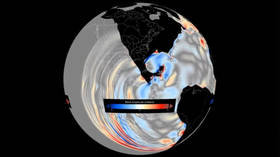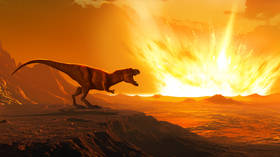
An international team of scientists simulated the global deluge triggered by an asteroid 66 million years ago

© Twitter/@NOAAeducation
An international group of researchers have used special software to reenact the giant tsunami that is believed to have wiped dinosaurs off the face of the Earth tens of millions of years ago. The asteroid-induced deluge saw mile-high waves wash over the planet, the scientists say.
On Monday, the US National Oceanic and Atmospheric Administration (NOAA) posted a snippet of the computer simulation on Twitter.
NEW from NOAA SOS: This dataset shows the tsunami wave caused by the asteroid that hit Earth 66 million years ago. The wave was so impressive because the asteroid is estimated to have been 6+ miles (10+ km) in diameter! Want to learn more? https://t.co/MHCGQ1VDEa#dataviz#Datapic.twitter.com/tbIxp7keoy
— NOAA Education (@NOAAeducation) January 30, 2023
The devastating natural event, which is said to have been 30,000 times more powerful than any tsunami on record, was set off when a massive asteroid struck where Mexico’s Yucatan Peninsula is currently situated, according to the scientists’ estimates. The celestial body is believed to have been more than 10km (6 miles) in diameter.
The asteroid left a deep mark where it landed that is now known as the Chicxulub crater. The collision triggered waves as high as 4.5km (2.5 miles) that rippled across the globe, as demonstrated by the new model.
The strike coincides with the Cretaceous-Paleogene extinction event that saw a whopping 75% of all flora and fauna on Earth at the time, including all non-winged dinosaurs, perish due to the massive devastation and ensuing climate change.

The computer simulation is the fruit of joint labors by researchers from several countries, including America’s NOAA’s Pacific Marine Environmental Lab and Geophysical Fluid Dynamics Lab.
The scientists combined numerical modeling and analysis of geological records to create what they describe as the “first global simulation of the Chicxulub asteroid impact tsunami.”
A powerful computer program that models details of complex fluid flows, named a hydrocode, recreated the first 10 minutes of the tsunami generation, while two more NOAA-developed models simulated patterns, according to which the waves spread across the globe. Researchers also analyzed geological records from more than 100 sites worldwide to back up their estimates.
According to the team, the study could be of practical use as it may help “assess and quantify the risk of future large asteroid impacts.” Moreover, the model could help forecast impacts of smaller-scale tsunamis that regularly occur nowadays.




